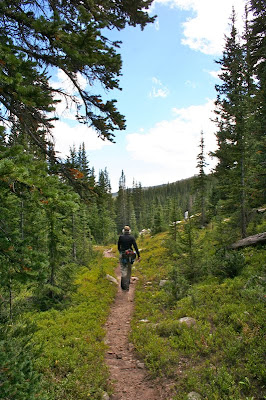Elevation: 10,800 ft (trailhead), 11,879 ft (on the plateau), 11,293 ft (at the lake)
Elevation Gain: 1,665 ft (cumulative)
Dogs: On Leash (Wilderness)
Tags: #coloradooutdoors, #travel, #mountainlake, #leadville, #hiking
Native Lake in the Mount Massive Wilderness near Leadville, CO is a wonderful trail filled with variety. The initial part of the trail switchbacks 2 miles through a Spruce/Fir forest. It is damp, mysterious, and filled with pizza-sized mushrooms, many of them edible. At 2.18 miles, you break out onto a wide tundra plateau. Here the edifice that is Mt. Massive (14,443 ft) dominates the western skyline. I did this hike in the fall when the tundra grasses were golden. I can imagine them being verdant in the spring. The views of Leadville from this plateau are expansive. The western skyline is filled with 14,000 ft peaks. Across the plateau, the trail descends 500 ft to a valley. It is there that Native Lake rests.
The lake itself is slowly receding and is being replaced by meadow grasses. The hike down to the lake was somewhat laborious too. If I were to do this hike again, I would stop part way down where you can see the lake from the ridge. That view is quite nice.
You get to the trailhead by driving west along Turquoise Lake to Hagerman Tunnel Road. This dirt road is narrow in places but is passable by a passenger car. Hagerman Pass road traces a long and narrow U. At the apex of the U is a wide area that contains 2 trailheads. Native lake is the first trailhead. It is situated slightly back from the road. The second parking area spans the road and is for ATVers heading up to the pass, and hardy hikers attempting the steep but scenic Windsor Lake. Farther up the road is the trail for Hagerman Tunnel.
This trail was a treat because of its flora. There is something about hiking in a Spruce/Fir forest in the fall. This forest ecosystem is more shaded than the Lodgepole forest that dominates much of the state. As such, it was cooler, damp, and definitely fall like. At the request of my hiking partner, I started taking pictures of all the mushrooms. I have never seen so many mushrooms in Colorado before. King Boleta and Scaly Urchins were particularly common. I discovered after the fact, that King Boleta is highly prized by wild mushroom connoisseurs. That is probably why I have not seen it before. They have been quickly snatched up by fanatical fungi followers.
The first 2 miles of the trail switchbacks up a single drainage as the trail climbs higher. It was obvious that some people chose to walk parallel to the creek and head straight up the hillside. The Forest Service has put dead fall all along this narrow social trail as a deterrent. Please stay on the trail even though it is much longer. The views of Hagerman Tunnel and pass are worth the extra effort.
I would recommend Native Lake to anyone. It is unpopulated and filled with changing views. If you are camping at Turquoise Lake, then you have no excuse what-so-ever!























































